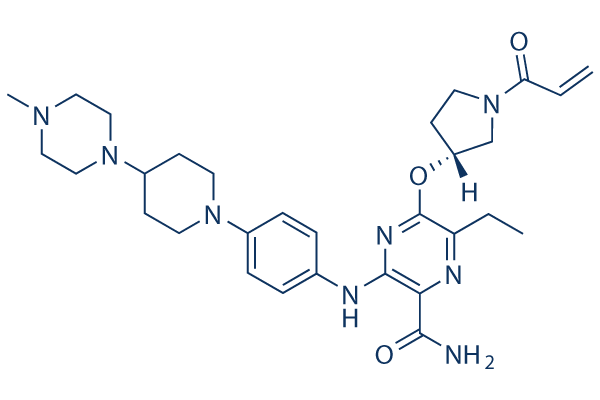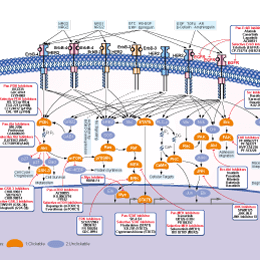
- Bioactive Compounds
- By Signaling Pathways
- PI3K/Akt/mTOR
- Epigenetics
- Methylation
- Immunology & Inflammation
- Protein Tyrosine Kinase
- Angiogenesis
- Apoptosis
- Autophagy
- ER stress & UPR
- JAK/STAT
- MAPK
- Cytoskeletal Signaling
- Cell Cycle
- TGF-beta/Smad
- DNA Damage/DNA Repair
- Compound Libraries
- Popular Compound Libraries
- Customize Library
- Clinical and FDA-approved Related
- Bioactive Compound Libraries
- Inhibitor Related
- Natural Product Related
- Metabolism Related
- Cell Death Related
- By Signaling Pathway
- By Disease
- Anti-infection and Antiviral Related
- Neuronal and Immunology Related
- Fragment and Covalent Related
- FDA-approved Drug Library
- FDA-approved & Passed Phase I Drug Library
- Preclinical/Clinical Compound Library
- Bioactive Compound Library-I
- Bioactive Compound Library-Ⅱ
- Kinase Inhibitor Library
- Express-Pick Library
- Natural Product Library
- Human Endogenous Metabolite Compound Library
- Alkaloid Compound LibraryNew
- Angiogenesis Related compound Library
- Anti-Aging Compound Library
- Anti-alzheimer Disease Compound Library
- Antibiotics compound Library
- Anti-cancer Compound Library
- Anti-cancer Compound Library-Ⅱ
- Anti-cancer Metabolism Compound Library
- Anti-Cardiovascular Disease Compound Library
- Anti-diabetic Compound Library
- Anti-infection Compound Library
- Antioxidant Compound Library
- Anti-parasitic Compound Library
- Antiviral Compound Library
- Apoptosis Compound Library
- Autophagy Compound Library
- Calcium Channel Blocker LibraryNew
- Cambridge Cancer Compound Library
- Carbohydrate Metabolism Compound LibraryNew
- Cell Cycle compound library
- CNS-Penetrant Compound Library
- Covalent Inhibitor Library
- Cytokine Inhibitor LibraryNew
- Cytoskeletal Signaling Pathway Compound Library
- DNA Damage/DNA Repair compound Library
- Drug-like Compound Library
- Endoplasmic Reticulum Stress Compound Library
- Epigenetics Compound Library
- Exosome Secretion Related Compound LibraryNew
- FDA-approved Anticancer Drug LibraryNew
- Ferroptosis Compound Library
- Flavonoid Compound Library
- Fragment Library
- Glutamine Metabolism Compound Library
- Glycolysis Compound Library
- GPCR Compound Library
- Gut Microbial Metabolite Library
- HIF-1 Signaling Pathway Compound Library
- Highly Selective Inhibitor Library
- Histone modification compound library
- HTS Library for Drug Discovery
- Human Hormone Related Compound LibraryNew
- Human Transcription Factor Compound LibraryNew
- Immunology/Inflammation Compound Library
- Inhibitor Library
- Ion Channel Ligand Library
- JAK/STAT compound library
- Lipid Metabolism Compound LibraryNew
- Macrocyclic Compound Library
- MAPK Inhibitor Library
- Medicine Food Homology Compound Library
- Metabolism Compound Library
- Methylation Compound Library
- Mouse Metabolite Compound LibraryNew
- Natural Organic Compound Library
- Neuronal Signaling Compound Library
- NF-κB Signaling Compound Library
- Nucleoside Analogue Library
- Obesity Compound Library
- Oxidative Stress Compound LibraryNew
- Plant Extract Library
- Phenotypic Screening Library
- PI3K/Akt Inhibitor Library
- Protease Inhibitor Library
- Protein-protein Interaction Inhibitor Library
- Pyroptosis Compound Library
- Small Molecule Immuno-Oncology Compound Library
- Mitochondria-Targeted Compound LibraryNew
- Stem Cell Differentiation Compound LibraryNew
- Stem Cell Signaling Compound Library
- Natural Phenol Compound LibraryNew
- Natural Terpenoid Compound LibraryNew
- TGF-beta/Smad compound library
- Traditional Chinese Medicine Library
- Tyrosine Kinase Inhibitor Library
- Ubiquitination Compound Library
-
Cherry Picking
You can personalize your library with chemicals from within Selleck's inventory. Build the right library for your research endeavors by choosing from compounds in all of our available libraries.
Please contact us at info@selleckchem.com to customize your library.
You could select:
- Antibodies
- Bioreagents
- qPCR
- 2x SYBR Green qPCR Master Mix
- 2x SYBR Green qPCR Master Mix(Low ROX)
- 2x SYBR Green qPCR Master Mix(High ROX)
- Protein Assay
- Protein A/G Magnetic Beads for IP
- Anti-Flag magnetic beads
- Anti-Flag Affinity Gel
- Anti-Myc magnetic beads
- Anti-HA magnetic beads
- Magnetic Separator
- Poly DYKDDDDK Tag Peptide lyophilized powder
- Protease Inhibitor Cocktail
- Protease Inhibitor Cocktail (EDTA-Free, 100X in DMSO)
- Phosphatase Inhibitor Cocktail (2 Tubes, 100X)
- Cell Biology
- Cell Counting Kit-8 (CCK-8)
- Animal Experiment
- Mouse Direct PCR Kit (For Genotyping)
- New Products
- Contact Us
Naquotinib(ASP8273)
Naquotinib (ASP8273) is an orally available, irreversible, mutant-selective, epidermal growth factor receptor (EGFR) inhibitor, with potential antineoplastic activity.

Naquotinib(ASP8273) Chemical Structure
CAS No. 1448232-80-1
Purity & Quality Control
Naquotinib(ASP8273) Related Products
Signaling Pathway
Biological Activity
| Description | Naquotinib (ASP8273) is an orally available, irreversible, mutant-selective, epidermal growth factor receptor (EGFR) inhibitor, with potential antineoplastic activity. | |
|---|---|---|
| Targets |
|
| In vitro | ||||
| In vitro | ASP8273 is a small-molecule irreversible TKI inhibitor that inhibits the kinase activity of EGFR mutations including T790M, with limited activity against EGFR wild-type (WT) NSCLC. In the in vitro enzymatic and cell-based assays, ASP8273 is evaluated against EGFR mutants (L858R, exon 19 deletion, L858R/T790M, and del19/T790M) and WT EGFR. ASP8273 is found by mass spectrometry to covalently bind to a mutant EGFR (L858R/T790M) via cysteine residue 797 in the kinase domain of EGFR with long-lasting inhibition of EGFR phosphorylation for 24 h. In the NSCLC cell lines harboring the above EGFR mutations, ASP8273 has IC50 values of 8-33 nM toward EGFR mutants, more potently than that of WT EGFR (IC50 value of 230 nM). ASP8273 is further shown to suppress the signaling pathway through ERK and Akt. ASP8273 even shows activity in mutant EGFR cell line which is resistant to other EGFR TKIs including AZD9291 and CO-1686[1][2]. | |||
|---|---|---|---|---|
| In Vivo | ||
| In vivo | In mouse xenograft studies, ASP8273 induces tumor regression in NCI-H1975 (L858R/T790M), HCC827 (del ex19) and PC-9 (del ex19) xenograft models by repeated oral dosing in a dose-dependent manner. Dosing schedules do not affect the efficacy of ASP8273. In HCC827 and NCI-H1975 xenograft models, ASP8273 induces tumor regression at 10, 30 and 100mg/kg without affecting body weight. ASP8273 also produces tumor growth inhibition from 10mg/kg in the NSCLC patient derived tumor xenograft, LU1868 which express T790M/L858R. On the other hand, ASP8273 does not produce significant tumor growth inhibition at 10 and 30mg/kg in A431 xenograft model[1][2]. | |
|---|---|---|
| NCT Number | Recruitment | Conditions | Sponsor/Collaborators | Start Date | Phases |
|---|---|---|---|---|---|
| NCT03082300 | Terminated | Non-small Cell Lung Cancer (NSCLC)|Epidermal Growth Factor Receptor (EGFR) Mutations |
Astellas Pharma Global Development Inc.|Astellas Pharma Inc |
March 24 2017 | Phase 1 |
| NCT02674555 | Withdrawn | Epidermal Growth Factor Receptor (EGFR) Mutations|Solid Tumors |
Astellas Pharma Global Development Inc.|Astellas Pharma Inc |
November 15 2016 | Phase 1 |
| NCT02500927 | Terminated | EGFR-TKI-naïve Patients With NSCLC Harboring EGFR Activating Mutations |
Astellas Pharma Inc |
June 25 2015 | Phase 2 |
| NCT02113813 | Completed | Non-Small-Cell Lung Cancer (NSCLC)|Epidermal Growth Factor Receptor Mutations |
Astellas Pharma Global Development Inc.|Astellas Pharma Inc |
April 9 2014 | Phase 1 |
| NCT02192697 | Terminated | Non-small Cell Lung Cancer |
Astellas Pharma Inc |
January 23 2014 | Phase 1|Phase 2 |
Chemical Information & Solubility
| Molecular Weight | 562.71 | Formula | C30H42N8O3 |
| CAS No. | 1448232-80-1 | SDF | Download Naquotinib(ASP8273) SDF |
| Smiles | CCC1=C(N=C(C(=N1)C(=O)N)NC2=CC=C(C=C2)N3CCC(CC3)N4CCN(CC4)C)OC5CCN(C5)C(=O)C=C | ||
| Storage (From the date of receipt) | |||
|
In vitro |
Ethanol : 100 mg/mL DMSO : 52 mg/mL ( (92.4 mM) Moisture-absorbing DMSO reduces solubility. Please use fresh DMSO.) Water : Insoluble |
Molecular Weight Calculator |
|
In vivo Add solvents to the product individually and in order. |
In vivo Formulation Calculator |
||||
Preparing Stock Solutions
Molarity Calculator
In vivo Formulation Calculator (Clear solution)
Step 1: Enter information below (Recommended: An additional animal making an allowance for loss during the experiment)
mg/kg
g
μL
Step 2: Enter the in vivo formulation (This is only the calculator, not formulation. Please contact us first if there is no in vivo formulation at the solubility Section.)
% DMSO
%
% Tween 80
% ddH2O
%DMSO
%
Calculation results:
Working concentration: mg/ml;
Method for preparing DMSO master liquid: mg drug pre-dissolved in μL DMSO ( Master liquid concentration mg/mL, Please contact us first if the concentration exceeds the DMSO solubility of the batch of drug. )
Method for preparing in vivo formulation: Take μL DMSO master liquid, next addμL PEG300, mix and clarify, next addμL Tween 80, mix and clarify, next add μL ddH2O, mix and clarify.
Method for preparing in vivo formulation: Take μL DMSO master liquid, next add μL Corn oil, mix and clarify.
Note: 1. Please make sure the liquid is clear before adding the next solvent.
2. Be sure to add the solvent(s) in order. You must ensure that the solution obtained, in the previous addition, is a clear solution before proceeding to add the next solvent. Physical methods such
as vortex, ultrasound or hot water bath can be used to aid dissolving.
Tech Support
Answers to questions you may have can be found in the inhibitor handling instructions. Topics include how to prepare stock solutions, how to store inhibitors, and issues that need special attention for cell-based assays and animal experiments.
Tel: +1-832-582-8158 Ext:3
If you have any other enquiries, please leave a message.
* Indicates a Required Field
Tags: buy Naquotinib(ASP8273) | Naquotinib(ASP8273) supplier | purchase Naquotinib(ASP8273) | Naquotinib(ASP8273) cost | Naquotinib(ASP8273) manufacturer | order Naquotinib(ASP8273) | Naquotinib(ASP8273) distributor







































